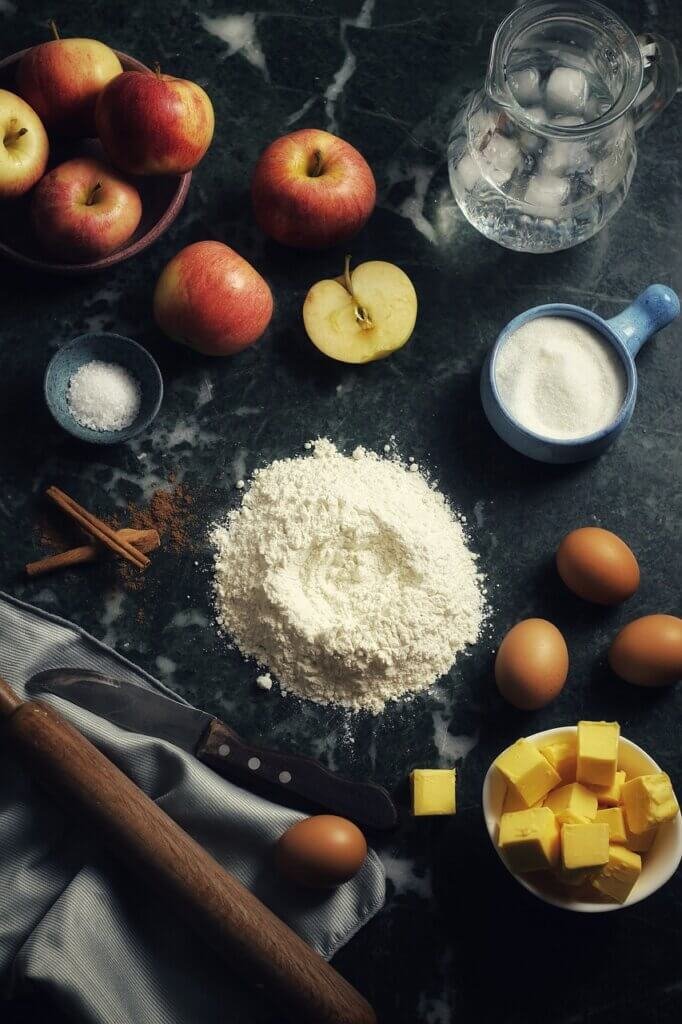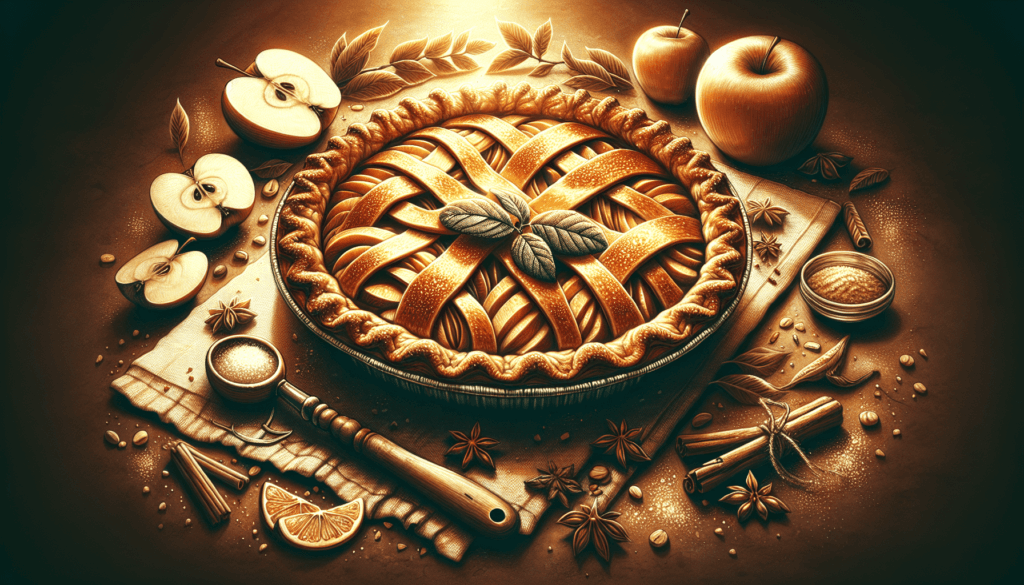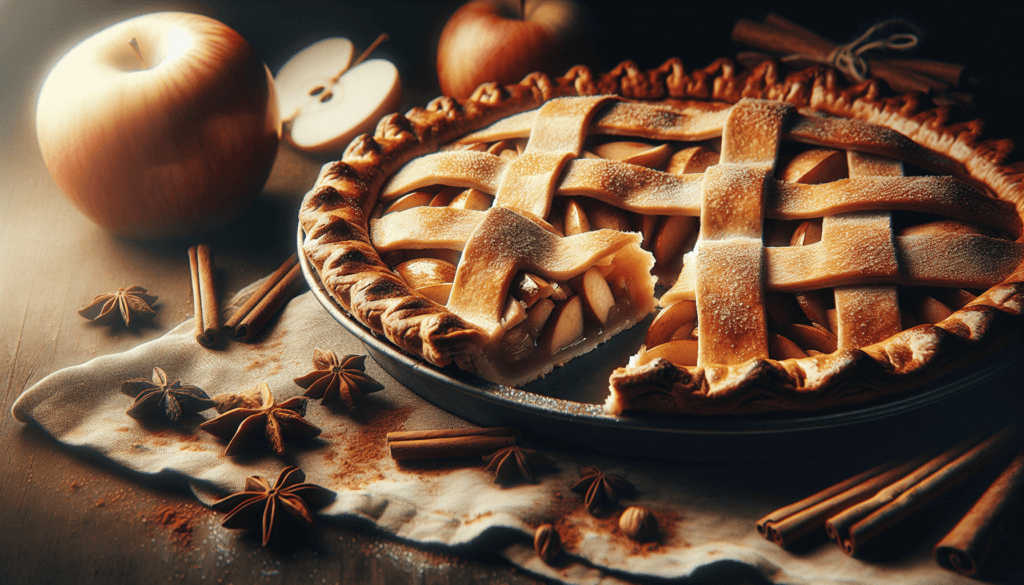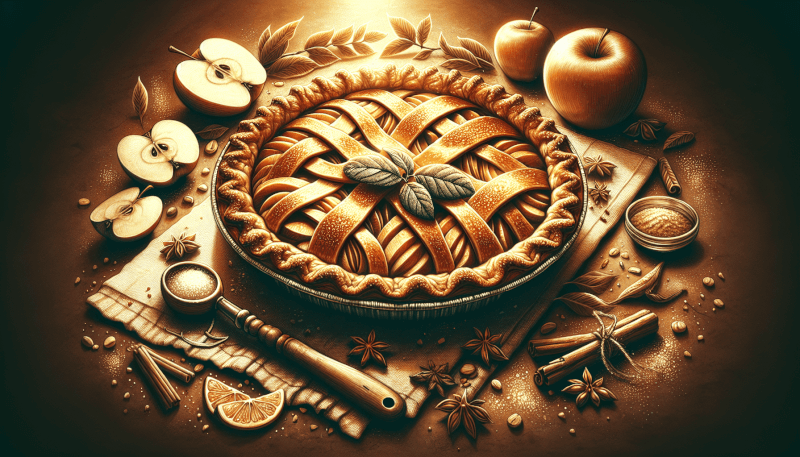If you’re craving a comforting dessert that never goes out of style, look no further than the classic apple pie. With its flaky crust and luscious filling, this timeless treat is a beloved favorite among pie enthusiasts of all ages. Whether enjoyed warm with a scoop of vanilla ice cream or savored cold for a sweet breakfast, the classic apple pie never fails to delight taste buds and evoke feelings of nostalgia. Get ready to indulge in a slice of pure comfort and experience the perfect harmony of tart apples, aromatic spices, and buttery pastry crust that make this pie a true culinary masterpiece.

History and Origin
Ancient Roots
Apple pie, with its iconic flaky crust and luscious apple filling, has a rich and storied history that dates back thousands of years. The concept of combining apples with pastry can be traced back to ancient times, with evidence of early apple-based pastries found in both Greek and Roman cuisine. These early versions of apple pies were prepared by enclosing the apples in a simple pastry made from flour, water, and fat, and then baking it until golden and fragrant.
Colonial America
The arrival of European settlers in North America brought the tradition of apple pie to the shores of the New World. In colonial America, apples were readily available and became a staple ingredient in many households. The early settlers frequently baked apple pies as a way to make use of their bountiful apple harvests. As apple trees thrived in the fertile soil of the new land, apple pie quickly became a beloved dessert and a symbol of American ingenuity and resourcefulness.
Popularization of Apple Pie
It wasn’t until the 19th century that apple pie truly gained widespread popularity in America. During this time, apple orchards flourished throughout the country, leading to an abundance of apples that were used in various culinary creations. The publication of numerous apple pie recipes in cookbooks and magazines further contributed to its rise in popularity. As the nation expanded westward, so did the love for apple pie, with homemakers from all walks of life perfecting their own unique recipes and methods.
Ingredients
Pie Crust
The foundation of any apple pie is the crust – a delicate, flaky shell that encases the luscious apple filling. A good pie crust should strike the perfect balance between tender and crisp, providing a sturdy base for the filling while still offering a satisfying texture. The crust is typically made with flour, salt, water, and fat, which can be either butter, shortening, or a combination of the two. The choice of fat can affect the flavor and texture of the crust, with butter lending a rich, buttery taste and shortening producing a more tender result.
Apples
Choosing the right apples is crucial for achieving a flavorful and well-balanced apple pie. The best apples for baking are those that hold their shape well and have a balance of sweetness and tartness. Varieties such as Granny Smith, Honeycrisp, and Jonathan are commonly used in apple pie recipes due to their firm texture and vibrant flavor. Mixing different apple varieties can also create a more complex flavor profile, with some apples lending sweetness and others providing tartness.
Sugar
Sugar plays a crucial role in sweetening the apple filling and balancing the natural tartness of the apples. The amount of sugar needed can vary depending on the sweetness of the apples and personal preference. Granulated sugar is commonly used, but other types of sugar, such as brown sugar or maple syrup, can be incorporated for added depth of flavor. It’s important to taste and adjust the sweetness of the filling to ensure it complements the apples without overpowering them.
Spices
The warm and comforting aroma of spices is an integral part of the apple pie experience. Cinnamon is the classic spice of choice, as it pairs beautifully with apples and imparts a cozy, autumnal flavor. Other spices commonly used include nutmeg, cloves, and allspice, which add depth and complexity to the filling. The spices should be added in moderation to enhance the apple flavor rather than overpowering it.
Butter
Butter adds richness and a velvety texture to the apple pie filling. As the pie bakes, the butter melts and mingles with the sugar and spices, creating a luscious sauce that coats the apples and infuses them with flavor. It’s important to use unsalted butter to control the saltiness of the overall pie, and to distribute the butter evenly throughout the filling for consistent flavor. Some recipes also call for dotting the top of the pie with butter before baking to enhance the golden crust.
Preparing the Pie Crust
Selecting the Right Flour
Choosing the right flour is crucial for achieving a tender and flaky pie crust. All-purpose flour is commonly used in pie crust recipes, as it strikes a good balance between protein content and tenderness. However, some bakers prefer using pastry flour or a combination of cake flour and all-purpose flour for an even more delicate crust. Whichever flour you choose, it’s important to measure it accurately and handle it gently to avoid gluten development, which can result in a tough crust.
Choosing the Fat
The choice of fat is one of the key factors in creating a flavorful and tender pie crust. Butter is a popular choice due to its rich flavor and the flakiness it imparts to the crust. Shortening, on the other hand, produces a tender and light crust that is less prone to shrinking during baking. Many pie crust recipes use a combination of butter and shortening for a balance of flavor and texture. Lard is another traditional fat that some bakers swear by for achieving an exceptionally flaky crust.
Mixing the Dough
To make the pie crust dough, the flour, salt, and fat are combined until the mixture resembles coarse crumbs. The fat is typically cut into the flour using a pastry blender, two knives, or even the fingertips. This step ensures the fat is evenly distributed in small pieces throughout the dough, which will result in a flaky texture. Some recipes call for adding a small amount of liquid, such as ice water or vinegar, to bring the dough together. It’s important not to overmix the dough to avoid developing gluten, which will make the crust tough.
Rolling and Shaping
Once the dough is prepared, it needs to be rolled out and shaped to fit the pie pan. The dough should be chilled for at least 30 minutes before rolling to allow the gluten to relax and prevent excessive shrinking during baking. On a lightly floured surface, the dough is rolled out into a thin, even circle, slightly larger than the diameter of the pie pan. Carefully transferring the dough to the pan, it can then be gently pressed into place and trimmed to create a decorative edge. If a double-crust pie is desired, the process is repeated to create the top crust.
Filling the Pie
Apple Selection
Selecting the right apples is crucial for a delicious apple pie. It is important to choose apples that hold their shape during baking and have a good balance of sweetness and tartness. Granny Smith apples are known for their tartness and firm texture, making them a popular choice for pies. Honeycrisp apples offer a good balance of sweetness and tartness, while Jonathan and Braeburn apples provide a rich and complex flavor. Experimenting with different apple varieties can result in unique flavor profiles.
Peeling and Slicing
Before filling the pie, the apples need to be peeled, cored, and sliced. A vegetable peeler can be used to remove the skin, revealing the crisp flesh underneath. Once peeled, the apples can be cut into slices of uniform thickness to ensure even cooking. Some bakers prefer thicker slices for a chunkier, more substantial filling, while others opt for thinner slices for a softer texture. It’s a matter of personal preference and can be adjusted to suit individual taste.
Sweetening and Flavoring
Once sliced, the apples are combined with sugar, spices, and sometimes a thickening agent such as flour or cornstarch. The amount of sugar used can vary depending on the tartness of the apples and personal preference. Spices such as cinnamon, nutmeg, and cloves are added to enhance the flavor profile of the filling. In addition to spices, some recipes suggest adding lemon juice or zest to brighten the flavor and balance the sweetness. The sweetening and flavoring ingredients should be mixed with the apples until well combined.
Adding the Final Touches
Before placing the top crust, the filling can be enhanced with a few final touches. Some bakers prefer to dot the filling with small pieces of butter, which will melt during baking and add richness to the filling. A sprinkling of sugar or a glaze made from beaten egg or milk can be brushed over the top crust to create an appealing golden color and shimmer. These final touches not only enhance the taste and appearance of the pie but also add a layer of complexity to the overall experience.

Baking the Pie
Preheating the Oven
Before baking the pie, it’s essential to preheat the oven to the specified temperature in the recipe. Preheating ensures that the heat is evenly distributed, resulting in a properly baked pie with a golden crust. The temperature may vary depending on the recipe, but most apple pies are baked at around 375°F (190°C). It’s important to follow the recipe instructions for optimal results.
Placing the Pie in the Oven
To bake the pie, it should be placed on the center rack of the preheated oven. This allows for even circulation of heat and ensures that the pie bakes evenly. Some bakers prefer to place the pie on a baking sheet or a pizza stone to help distribute the heat more evenly and catch any drips that may occur during baking. It’s important to avoid overcrowding the oven, as this can restrict air circulation and result in uneven baking.
Monitoring the Baking Process
During the baking process, it’s important to keep an eye on the pie to ensure it doesn’t overcook or undercook. The pie should be checked periodically to gauge its progress. The crust should turn a golden brown color, indicating that it is fully baked. The filling should be bubbling and fragrant, with the apples appearing tender but not mushy. It can be helpful to rotate the pie halfway through baking to ensure even browning.
Achieving a Golden Crust
For a beautifully golden crust, there are a few techniques that can be employed. Brushing the top crust with an egg wash – a mixture of beaten egg and a small amount of water or milk – can create a glossy sheen and enhance browning. Sprinkling a small amount of sugar on top of the crust can also contribute to its golden appearance. Additionally, covering the edges of the pie crust with foil or a specialized pie shield during baking can prevent them from becoming too brown.
Serving Suggestions
Warm or Cold
Apple pie can be enjoyed both warm and cold, each offering a unique sensory experience. Straight out of the oven, a warm slice of apple pie is indulgently comforting, with the buttery crust and fragrant filling melding together in a heavenly combination. The warmth of the pie is particularly appealing during the colder months or on special occasions. On the other hand, chilled apple pie has a refreshing quality, with the flavors mellowed and the textures slightly firmer. It’s a delightful option for a summer dessert or a refreshing twist.
Whipped Cream or Ice Cream
To elevate the apple pie experience, a dollop of freshly whipped cream or a scoop of vanilla ice cream is a classic accompaniment. The creamy and slightly tangy flavor of whipped cream adds a luscious contrast to the warm or cold pie, enhancing its richness. On the other hand, the cold and creamy texture of ice cream provides a refreshingly cool counterpoint to the pie’s warmth. The melting ice cream cascading over the pie, with its sweet, creamy flavor, creates a blissful contrast that is hard to resist.
Caramel or Cheddar Cheese
For those looking to take their apple pie experience to the next level, drizzling it with warm caramel sauce can be a decadent indulgence. The sticky sweetness of the caramel complements the natural sweetness of the apples, creating a symphony of flavors. Another unconventional yet delightful pairing is a slice of sharp cheddar cheese served alongside the apple pie. The combination of the savory, tangy cheese and the sweet, spiced filling creates a delightful contrast that is both unexpected and utterly delicious.
Accompaniments for Brunch
Apple pie isn’t just for dessert. It can also be a delightful addition to a brunch menu, offering a touch of sweetness to balance out savory dishes. Served alongside breakfast classics such as eggs, bacon, and toast, apple pie can provide a surprising and delicious twist. The buttery crust and sweet filling create a harmonious pairing with the savory flavors of brunch, making it a memorable and indulgent addition to the table.
Pairing with Coffee or Tea
A slice of apple pie pairs wonderfully with a steaming cup of coffee or a fragrant cup of tea. The rich, roasted flavors of coffee complement the warm, buttery notes of the pie, creating a comforting and flavorful combination. On the other hand, the delicate and aromatic nuances of tea can enhance the intricate flavors of the pie, offering a more delicate and subtle pairing. Whether you prefer a robust cup of coffee or a fragrant cup of tea, the combination with apple pie is sure to satisfy your taste buds.

Variations
Dutch Apple Pie
A Dutch apple pie is a delightful twist on the classic apple pie, featuring a streusel topping instead of a second crust. The streusel, made from butter, flour, sugar, and spices, creates a crunchy and sweet topping that perfectly complements the tender apple filling. The streusel adds an extra layer of texture and flavor to the pie, making it a favorite among those who prefer a bit of indulgence. Dutch apple pie can be served warm or chilled and is a crowd-pleasing option for any occasion.
French Apple Pie
French apple pie, also known as tarte aux pommes, showcases the elegance and simplicity of French pastry. Made with a buttery pâte brisée crust and thinly sliced apples arranged in an attractive pattern, it is a work of art as much as it is a delicious dessert. The thinly sliced apples are lightly sweetened and glazed with apricot jam for a glossy finish. French apple pie is typically served at room temperature, allowing the flavors to fully develop and creating a refined and delectable treat.
Caramel Apple Pie
Caramel apple pie takes the classic apple pie to new heights with the addition of rich caramel sauce. The apples are combined with caramel sauce, creating a gooey and decadent filling that is intensely flavored and utterly irresistible. A drizzle of caramel sauce on top of the pie before serving adds an extra touch of indulgence. The combination of the sweet and spiced apples with the rich caramel creates a flavor profile reminiscent of a caramel apple dipped in a warm, buttery caramel sauce.
Streusel-Topped Apple Pie
A streusel-topped apple pie offers a delightful twist on the traditional apple pie. Instead of adding a top crust, the pie is adorned with a buttery streusel topping made from flour, sugar, butter, and spices. The streusel adds a deliciously crunchy and sweet element to the pie, creating a textural contrast to the tender apple filling. The streusel can be customized with the addition of chopped nuts, oats, or even crushed cookies for added flavor and texture.
Apple Pie with a Cheddar Crust
For those who enjoy the combination of sweet and savory flavors, apple pie with a cheddar crust is a must-try variation. A layer of sharp cheddar cheese is incorporated into the pastry crust, adding a tangy and savory note to the pie. The savory crust pairs beautifully with the sweet and spiced apple filling, creating a unique and unexpected flavor profile. The cheddar crust adds a rich and complex dimension to the pie, making it a memorable and conversation-starting dessert.
Apple Pie Around the World
United States
Apple pie is deeply ingrained in American culture and has become a symbol of American tradition and patriotism. It is often associated with holidays, particularly Thanksgiving, where it takes center stage as a beloved dessert. In the United States, apple pie is enjoyed in various forms and for different occasions, from casual family dinners to elaborate celebrations. It represents the spirit of resourcefulness and creativity that is deeply valued in American cuisine.
England
Apple pie has a long history in England and is considered a classic British dessert. The term “as American as apple pie” may be used, but apple pie holds a special place in British culinary traditions as well. In England, apple pie is typically made with a sweet shortcrust pastry and a chunky apple filling that is lightly spiced with cinnamon or nutmeg. It is often served with custard or a dollop of clotted cream, adding a luxurious and creamy element to the comforting dessert.
Netherlands
The Netherlands has its own unique twist on apple pie known as appeltaart. Dutch apple pie features a buttery, cookie-like crust made with a combination of flour, sugar, butter, and eggs. The filling consists of thinly sliced apples enhanced with cinnamon, sugar, and sometimes raisins and lemon zest. Dutch apple pie is typically served with a generous dollop of freshly whipped cream, providing a creamy and luxurious finish to the sweet and aromatic dessert.
Sweden
In Sweden, apple pie, or äppelpaj, is a beloved dessert enjoyed throughout the year. It typically features a tender and buttery crust paired with a simple apple filling made with sliced apples, sugar, and cinnamon. In some variations, breadcrumbs, oatmeal, or almond paste may be added to the filling for added texture and flavor. Swedish apple pie is often enjoyed with a scoop of vanilla sauce or vanilla ice cream, adding a luscious and creamy element to the dessert.
France
In France, apple pie takes the form of tarte aux pommes, which showcases the elegance and finesse of French pastry. The crust is made with buttery pâte brisée or pâte sucrée, and the apples are thinly sliced and arranged in an attractive pattern. The filling may be lightly sweetened, and the top of the tart is typically glazed with apricot jam for a glossy finish. Tarte aux pommes is a popular dessert in France, often enjoyed with a cup of coffee or tea after a meal.
Symbolism and Cultural Significance
American Tradition
Apple pie holds a special place in American culture, representing tradition, nostalgia, and a sense of home. For many Americans, apple pie is a staple dessert, particularly during holidays and family gatherings. It is often associated with a sense of comfort and familiarity, evoking memories of shared meals and cherished moments. Apple pie embodies the values and ideals that Americans hold dear, such as resourcefulness, resilience, and the pursuit of happiness.
Thanksgiving Symbol
Apple pie is an iconic dessert during Thanksgiving, a holiday that celebrates gratitude and togetherness. It is often enjoyed alongside other traditional dishes, such as roast turkey and mashed potatoes, symbolizing the abundance and blessings of the harvest season. In many households, the aroma of freshly baked apple pie filling the air is a quintessential part of the Thanksgiving experience, creating a warm and inviting atmosphere that brings loved ones together.
Homemade Comfort
The act of baking an apple pie from scratch is often associated with love and care. Homemade apple pie represents the comfort and nourishment that comes from a labor of love. The process of peeling and slicing apples, mixing the spices, and rolling out the crust is a tactile and sensory experience that connects people to the tradition of generations past. Sharing a slice of homemade apple pie with family and friends is a way to create lasting memories and build cherished traditions.
Folklore and Literature
Apple pie has captured the imagination of storytellers throughout history, becoming a symbol of comfort, tradition, and simplicity. It is often mentioned in folklore, literature, and songs as a representation of home and hearth. In American literature, apple pie is frequently used as a metaphor for the idyllic and nostalgic notion of the American Dream. It has become an enduring symbol of domesticity, values, and a shared cultural heritage.
Popular Phrases and Quotes
The popularity and cultural significance of apple pie have given rise to numerous phrases and quotes that have become woven into the fabric of American language. Expressions like “as American as apple pie” or “easy as pie” invoke the familiarity and simplicity associated with apple pie. They illustrate the idea of something that is quintessentially American, easily understood, or effortlessly accomplished. These phrases reflect the enduring legacy and cultural resonance of apple pie in American society.
The Perfect Apple Pie
Tips for Success
Creating the perfect apple pie requires attention to detail and a few expert tips. First and foremost, choosing the right apples is crucial. Opt for apples that hold their shape during baking and have a good balance of sweetness and tartness. Remember to adjust the sweetness of the filling to complement the apples without overpowering them. For a flaky and tender crust, handle the dough gently and avoid overmixing. Chilling the dough before rolling it out helps prevent shrinkage during baking.
Common Mistakes to Avoid
When making apple pie, some common mistakes can lead to less than ideal results. One common mistake is using overly ripe or mealy apples that will turn mushy during baking. It’s also important to avoid overloading the pie with too many apples, as this can result in a soggy crust and uneven cooking. Another pitfall is neglecting to properly pre-cook the filling before baking, which can lead to undercooked apples. Finally, resist the temptation to cut into your pie immediately after baking, as it needs time to set and cool to achieve the perfect texture.
Storage and Reheating
To store apple pie, allow it to cool completely before covering it tightly with plastic wrap or aluminum foil. It can be stored at room temperature for up to two days or refrigerated for three to five days. When reheating apple pie, it is best to place individual slices in a preheated oven or toaster oven at a low temperature until warmed through. This helps to preserve the flakiness of the crust while ensuring that the filling is heated evenly. Microwaving can result in a soggy crust, so it is not recommended for reheating apple pie.
Customizing and Personalizing
One of the joys of making apple pie is the opportunity to customize and personalize it according to individual tastes. Experimenting with different apple varieties or mixing them together can create unique flavor profiles. Adding a touch of citrus zest or a splash of vanilla extract to the filling can introduce an extra layer of complexity. The spices can also be adjusted based on personal preference, and additional ingredients such as nuts or dried fruits can be incorporated for added texture and flavor. The possibilities for customization are endless, allowing each baker to create their own signature apple pie.


